|
[Front Page] [Features] [Departments] [Society Home] [Subscribe]

Short Cuts
Readers are invited to submit short items of interest about Australian plants to be included here. If submitting non-original material (eg newspaper or magazine cuttings), please also advise if the author has given permission to republish and, if not, please provide a contact address so that permission can be sought.
Short Cuts in this issue:
 Bush Tucker - Bunya Nuts Bush Tucker - Bunya Nuts
- Bunyas are widely planted....but how do you keep and prepare the seeds??
 Grevillea australis - Southern or Alpine Grevillea Grevillea australis - Southern or Alpine Grevillea
- The variation in this species causes a few botanical headaches
 Successful Persoonia germination Successful Persoonia germination
- Not the definitive answer but an idea worth pursuing?
 Goodia: No Seed...No Name Goodia: No Seed...No Name
- Distinguishing between the two species of Goodia depends on the availability of seed.
 Lace Flower - Melaleuca thymifolia Lace Flower - Melaleuca thymifolia
- A beautiful species suited to the smallest garden
 Our Parasitic Plants Our Parasitic Plants
- Letting other plants do most of the work....

Bush Tucker - Bunya Nuts
The large nuts produced by the Bunya Pine (Araucaria bidwillii) were prized by Aborigines as a bush food and, with a little care, they can enhance modern-day cooking. Jan Sked has been researching...
The Bunya pine, (Araucaria bidwillii) is a large tree, growing 30-45 metres in height, with a straight, rough barked trunk and a very distinctive, symmetrical, dome-shaped crown. It has sharply pointed, lance-shaped leaves, about 2.5cm long, which make it uncomfortable to be around if barefoot, as it drops twigs and leaves frequently. The timber of the Bunya pine is beautifully grained and is highly valued as a cabinet timber and by woodworkers.
It is an emergent species in rainforest and is confined to Queensland, where it occurs mainly between Nambour and Gympie and west to the Bunya Mountains, with a small occurrence in north Queensland on Mt. Lewis and at Cunnabullen Falls.
The tree produces large green cones the size of footballs, each containing 50-100 large "nuts" which are encased within a woody shell. The kernel of this nut is a pale beige colour with a firm but waxy texture. The interior of the shell is lined with a fine brown fibre, some of which usually adheres to the nut, but can be eaten with no problems. Cones are to be found during late January and early February in the coastal districts of southern Queensland, and usually about March in the Bunya Mountains. They are not produced every year.
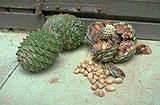 |
The large cones of the Bunya pine, Araucaria bidwillii can be leathal when they fall from high up in the tree!
Select the thumbnail image or highlighted name for a higher resolution image (37k). Photo: Jan Sked
|
These Bunya nuts were a rich source of food for the Aborigines of south-east Queensland. During the Bunya season they would temporarily set aside their tribal differences and gather in the mountains for great Bunya Nut Feasts.
The Aborigines ate the nuts raw or roasted, and they also buried them in mud for several months. This was said to greatly improve the flavour and may have been a means of storing them. Certainly, raw nuts in their shells, that have been stored in the bottom of the refrigerator in a sealed container for several months, have a much sweeter taste, and are as fresh as the day they fell from the tree, even though the shells may look a bit mouldy.
I have found many uses for the fruit of the Bunya pine, both cooked and raw and in savoury and sweet dishes. It is one of the most versatile and useful of all our native foods. My family and friends have been mostly willing, but sometimes unwitting guinea pigs, as I researched various recipes for the "Go Native - Wild Food Cookbook". So far I have used the nuts in soups, casseroles, quiches, pies, pastas, vegetables, desserts, cakes, biscuits, bread, damper, scones, pikelets, pastry, lollies and porridge.
The simplest way to prepare Bunya nuts for eating is to put them in a saucepan of water and boil for about half an hour. Remove from the water and split open while still hot. Remove from the shell and serve with butter (pepper and salt if required). They may be eaten cold, but are better hot.
From the September 1999 issue of the newsletter of the Queensland Region of SGAP.
[ Return to Index ]

Grevillea australis - Southern or Alpine Grevillea
When it comes to Grevillea, Tasmania is a bit deprived - a solitary species. But, as Jeanette Closs explains, lack of numbers does not mean lack of variety......
The genus Grevillea was named by Robert Brown after (Charles Francis Greville (1749-1809), a founder of the Horticultural Society in London. Robert Brown also named this species 'australis' meaning southern, and this is well named as it is the southern-most species of Grevillea in the world.
Dr Winifred Curtis in her "The Student's Flora of Tasmania" lists 7 varieties of this species. This is an indication of the variation of this species in Tasmania and there are many other locations in the mountain areas of Victoria and New South Wales where it can be found.
The following are the varieties listed by Dr Curtis and the localities where they are recorded.
- G.australis var. erecta - Lake St Clair and central plateau
- G.australis var. Iinearifolia - East Coast at Swanport and North Esk River
- G.australis var. planifolia - lowlands between Launceston and Devonport
- G.australis var. montana - Western Tiers
- G.australis var. brevifolia - Great Lake at 3,500 feet, Mt Barrow
- G.australis var. subulata - South Esk River
- G.australis var. tenuifolia - River Nile at 700 feet.
Don McGillivray (in his revision published in 1993) states that within G.australis there are readily observable differences between populations, principally in the shape and venation of leaves, but floral features are comparatively uniform and recognition of subspecific taxa is not warranted. However, detailed study of habit, leaf form and foliar venation patterns in relation to geographical distribution would enhance our understanding of this species.
 |
While not as flamboyant as some other grevilleas, Grevillea australis is an attractive species worthy of cultivation.
Select the thumbnail image or highlighted name for a higher resolution image (37k). Photo: Neil Marriott
|
In the three volumes of "The Grevillea Book" by Peter Olde and Neil Marriott published in 1994, only four varieties are acknowledged and these seem to simplify identification of the species in Tasmania.
- G.australis var. australis includes var. linearifolia and var. erecta. It is an erect shrub 0.5 - 2 m tall with spreading linear to lanceolate leaves up to 4 cm long with the margins shortly recurved.
- G.australis var. planifolia is an erect shrub with thick flat rounded leaves up to 3 cm long with a sharp tip, one conspicuous longitudinal vein and slightly recurved margins This form may only be found in the lowlands of northern Tasmania but a form with 3 conspicuous longitudinal veins is prostrate and shrubby and occurs in mountain areas of Victoria and New South Wales.
- G.australis var. brevifolia includes var. montana and it is a stiff, low or prostrate shrub spreading to about a metre wide. It has stiff narrow leaves up to 1 cm long with a sharp tip. The type specimen was collected by R.C. Gunn on Mt Barrow and it is also recorded at the Great Lake in Tasmania. Mainland forms differ from these in that longitudinal venation is sometimes visible on the upper surface of the leaves.
- G.australis var. tenuifolia includes var. subulata and is an erect shrub 1 - 1.5 m tall, erect needle-like leaves up to 1 cm long and with margins rolled so tightly that the undersurface is obscured . This variety is found on the mainland as well as in Tasmania.
Tasmania's only Grevillea is usually found in moist situations, sometimes growing over and among rocks or on the edge of streams and swamps, occasionally in grassland. The flowers in all forms appear to be similar, except for var. brevifolia. In my garden has much smaller flowers and I would think that it would be so in the wild. The tiny flowers are creamy white and terminal, and flowering lasts through spring and summer. Some forms have a strong honey perfume.
From the May 1999 issue of the ASGAP Newsletter.
[ Return to Index ]

Successful Persoonia Germination
Propagation of Persoonia species is always a "hit or miss" affair. Glenn Leiper of Jacob's Well Environmental Education Centre applied some lateral thinking and had a bit of success. The message here is "first select your chook".....
Over the years I've tried unsuccessfully to germinate many Persoonia (Geebung) seeds. Seed of P.virgata, P.sericea, P.stradbrokensis, P.cornifolia and P.tenuifolia has all rotted away in the seed-raising mix, often sitting for a couple of years and showing no sign of life. It became obvious that some factor was lacking that initiated the germination process.
Apparently many nurseries have tried Persoonia seed germination over the years and met with similar results. All sorts of techniques and strategies have been used, all to no avail. In the field, you often see Persoonia seedlings, so some natural process has given these seeds the trigger to get going. As Persoonia fruit are edible, I figured that the action of an animal's digestive process might provide that necessary trigger.
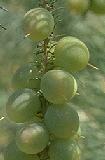 |
Fruit of the pine-leaved geebung, Persoonia pinifolius.
Select the thumbnail image or highlighted name for a higher resolution image (29k).
|
Late 1998, we had a fledgling Redeyed Figbird given to us by a local resident, as we often raise and eventually release orphaned birds. We had never tried a figbird before we took up the challenge. During the summer months there was no shortage of small fruit and berries such as Eugenia reinwardtiana, Austromyrtus dulcis and Syzygium luehmannii. The figbird devoured these with great relish.
During a bushwalk one day I collected some Persoonia stradbrokensis fruit and thought I'd give it a try on the figbird, with the eventual aim of sowing the 'passed' seed.
The figbird gobbled down the fruit and I collected the seed from the bird's droppings the next day. There was certainly no massive obvious change in the Persoonia seeds' appearance. In fact, they still had most of the flesh on them. I thought about feeding them back to the figbird a second time, but had second thoughts on my duty of care! So I sowed the 8 seeds that day, on I5 November 1998.
I put the pot of seed in our Centre's nursery under the automatic watering system, and promptly forgot them. I eventually remembered to check them in May 1999 and lo and behold, three seedlings! Unfortunately, I gave the seedlings away without waiting to see if any more would eventually germinate.
And what makes it even more unfortunate, we released the figbird some months ago! It returns every few weeks for a feed of Eugenia reinwardtiana, but the experiments with Persoonia seed have finished!
After my experiments with this 'treatment' process, I wonder if it is possible to use other birds in the same way? While it was relatively easy (although a little unpleasant) to collect seed from the figbird's droppings, I suspect the task may be rather more difficult logistically with chooks and ducks!
From the September 1999 issue of the newsletter of the Queensland Region of SGAP
[ Return to Index ]

Goodia: no seed, no name
Timothy Entwisle, formerly of the National Herbarium of Victoria, looks at the difficulty involved in identifying a common pea-flowered plant of southern Australia
Jim Ross, Chief Botanist at the National Herbarium of Victoria, concludes that for the legume genus Goodia, 'if you ain't got seeds you ain't got a name'. Ross didn't quite put it like that, but that's the nub of his conclusion.
Until Ross's study, nobody was sure how many species there were in this endemic Australian genus. George Bentham, in the second volume of his Flora Australiensis in 1864, recognised two species: G.Iotifolia and G.pubescens. H.B. Williamson, in Ewart's Flora of Victoria of 1931, accepted only one species (G.Iotifolia) with two varieties.
Jim Willis, in his Handbook, followed Williamson's treatment of pubescens as a variety of G.Iotifolia, but resurrected the Mueller name medicaginea as a species name for a entity extending from western Victoria through to Western Australia (so that's two species and a variety). In Tasmania, Bentham's concept of two species (with G.medicaginea synonymised under G.Iotifolia) was invoked, while in South Australia, Williamson's view reigned supreme.
With mature pods in hand, Ross found the interpretation of Willis best explained the variation he observed. The critical character is a little wordy: 'the length of the foot of the aril at its point of attachment to the seed'. This is the only reliable way to separate the species: the foot is 1.4-2 mm long in G.Iotifolia, and up to 1.1 mm long in G.medicaginea. In the absence of mature fruit, Ross remarks, it can be 'unquestionably difficult' to differentiate the species.
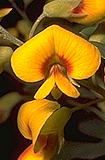 |
A roadside plant of Goodia in north-east Victoria. Without fruits it is impossible to tell if it is G.medicaginea or G.lotifolia
Select the thumbnail image or highlighted name for a higher resolution image (26k).
|
If may help to learn that all Western Australian and South Australian populations are referable to G.medicaginea, and all Tasmanian populations to G.Iotifolia. In the eastern mainland states, the ranges of the two species only overlap in Victoria. In such areas, in the south-west and north-east of the State, G.medicaginea tends to be on drier and more inland sites than G.Iotifolia.
Oh, and the two varieties of G.Iotifolia are distinguished as they always have been, on the basis of the hairiness of the young branchlets and the undersurface of the leaves: var. pubescens is densely hairy and var. Iotifolia is not.
Reference:
Ross, J.H. (1997). Notes on Goodia (Fabaceae, Bossiaeeae). Muelleria 10, 1-1 1.
From the September 1997 newsletter of the Australian Plants Society (Victoria)
[ Return to Index ]

Lace Flower - Melaleuca thymifolia
A small, hardy plant, suited to many climates and soils ....and in a range of flower colours. What more do you want?!! Colin Cornford, leader of the Melaleuca and Allied Genera Study Group takes up the story....
Melaleuca thymifolia grows in coastal heathland in sandy soils which are periodically quite wet. The standard or type form grows to about 1 m by 1 m and carries mauve-purple, occasionally white, flowers during spring and summer. There are a number of forms of this plant available all of which are easy to grow.
I have two plants in the garden here at Bracken Ridge, Queensland, which are tall-growing varieties. One of these grew to some 2.3 m with a very upright habit. This has been cut back to ground level and is coming away nicely from the base. The other tall-growing variety is kept pruned to beginner about 1.3 m. Flower colour of these forms is mauve-purple.
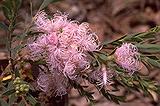 |
Melaleuca thymifolia is a hardy and attractive plant which takes up little space.
Top: M.thymifolia ("Pink Lace").
Bottom: M.thymifolia ("White Lace".
Select the thumbnail image or highlighted name for a higher resolution image (40k and 25k).
|  |
There are a number of cultivars of Melaleuca thymifolia on the market:
- Melaleuca thymifolia 'Pink lace' grows to about 1 m and is a fairly open shrub. Flowers are larger then those of the standard form and are pale pink in colour.
- Melaleuca thymifolia 'White Lace' has similar growth habit to that of 'Pink Lace' except that the flowers are pure white in colour.
- Melaleuca thymifolia 'Little Beauty' is a small compact form, usually around 1.5 m with mid-pink flowers.
- Melaleuca thymifolia 'Cotton Candy' is, to my mind, the best of the cultivars. It is a densely foliaged plant to about 1 m in height (occasionally slightly larger) with a spread of about 2 m and bright pink flowers which are produced over a long period of the year. Flowers are produced in leaf axils along most of the branches and when fully in flower it is quite spectacular.
- Melaleuca thymifolia "dark purple form" is similar in growth habit to the type form except that the flower colour is a deep purple.
The type form and the various cultivars are hardy under most conditions in Brisbane. Are they being grown further south? If you have any growing, please let me know what degree of success you have had.
From "Australian Plants", Vol.20, No. 159, June 1999
[ Return to Index ]

Our Parasitic Plants
There's more to parasitic plants than the centuries old European tradition of kissing under the mistletoe at Christmas time, with snow and log fires. Carl Lanham explains.......
Mistletoes are predominately tropical plants, with more than 13,000 species distributed around the world. Some 75 species occur in Australia, most of them in the warmer northern half of the continent.
The evolution of mistletoe is shrouded in the mists of time, but some botanists believe that its origin goes back as far as Gondwana, and with the movement of continents to their present positions, mistletoe was thus located in all the southern land masses. Since then, however, the mistletoes have greatly penetrated the tropical zones of the world. They have become very well established in Australia in great number and variety, and have undergone substantial changes in the last 60 million years .
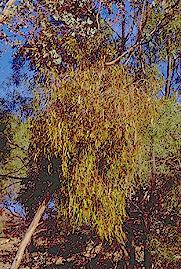 
Today mistletoes occur in almost all forests and woodlands in this continent, ranging from coastal mangroves to high mountain forests. In areas such as tropical rainforests, they tend to occur high in the canopy and are not always apparent. Sometimes the flowers that have fallen to the forest floor indicate their position. In dry open forests, where light is better, mistletoes may grow on trees at all levels, and their distinctive clumps of leaves and berries are a feature of the Australian forests.
In tropical rainforest a single species of mistletoe is normally found growing on a variety of host plants. This is because in the rainforest rarely does one host species become dominant in an area. If mistletoe was to be restricted to only one kind of host tree its chances of dispersal would be far too low.
On the other hand in a dry forest situation one kind of tree is usually dominant, a eucalypt. In this case the mistletoe may benefit from being closely adapted to growth on just one kind of tree. In some cases this adaption has developed to a stage where we find mimicking of the foliage of the host tree. This adaption is one of the unusual phenomena in plants which use parasitism as a way of existence.
A primitive form of parasitism in mistletoes is that in which the plant develops absorbing connections between its roots and those of neighbouring plants. Above the ground there is no sign of any form of parasitic relationship. Root parasites often have connections only with the water conducting tissue of the host' s roots. Here they obtain all the water required. Food is manufactured in the usual way, through chlorophyll in their leaves. These plants are free-standing, their roots are in the ground. This gives them a very wide range of plants to extract moisture from.
Nuytsia floribunda (The Western Australian Christmas Tree) is a striking example of this kind of root parasitic plant. This wonderful tree will grow to 20 metres or more. In summer it becomes covered in golden flowers for months. No plant within 150 metres of this tree is safe from its moisture seeking roots. Not even the home vegetable patch is safe.
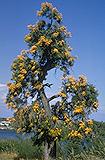 |
One of Australia's most spectacular trees, Nuytsia floribunda is difficult to maintain in cultivation due to its parasitic habit.
Select the thumbnail image or highlighted name for a higher resolution image (32k). Photo: Owen Roberts
|
There is a highly developed group of parasitic plants which start life as normal ground dwelling plants. Then, after attaching themselves to a nearby tree, the lower part of the plant dies leaving the rest of the plant dependent on the host plant for most, or all of its requirements. Even more specialised are the group of plants which include the 75 or so species of mistletoe found in Australia. Growth habits of these plants have become so modified that their seeds germinate on the branches of the host trees. This particular type of plant never has any contact with the ground.
It should be made clear that mistletoe and other aerial parasitic plants are not related in any way to epihytic plants. Plants such as orchids which share these lofty perches do not take anything from the host at all. These are free living plants taking their nutrients from organic matter and rain water.
From "Gumleaves", newsletter of the Hunter District Group of the Australian Plants Society (NSW)
[ Return to Index ]

[Front Page] [Features] [Departments] [Society Home] [Subscribe]
Australian Plants online - December 1999
Association of Societies for Growing Australian Plants
|